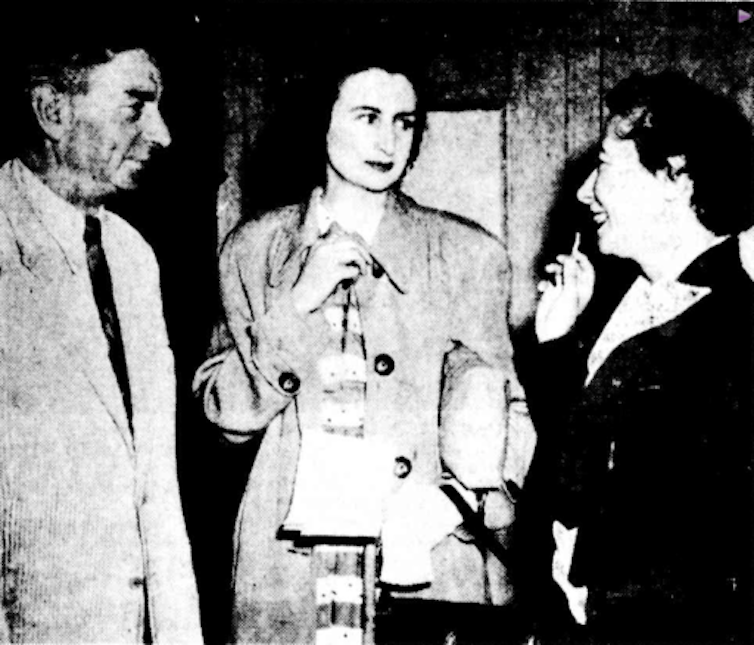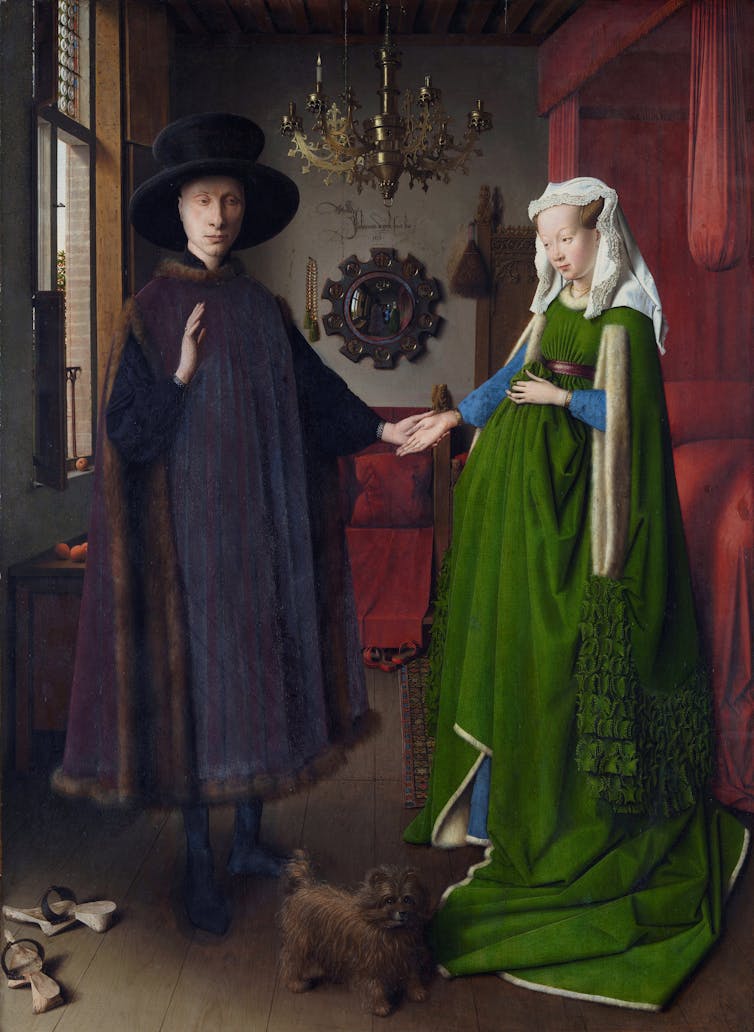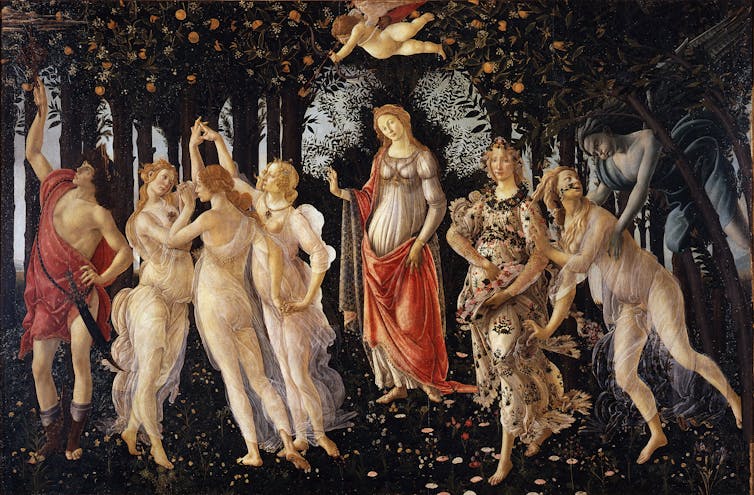the poetry of Rosemary Dobson
- Written by Peter Kirkpatrick, Senior Lecturer in Australian Literature, University of Sydney
In our series, Guide to the classics, experts explain key works of literature.
In the first century BCE the Roman poet Horace proposed that, “A poem is like a picture”, meaning that, like painting, poetry engages in mimesis by imitating life, copying it in a fixed medium. But what happens when art imitates art, as in Australian poet Rosemary Dobson’s poem, For the Painter Ben Nicholson, about the work of the British modernist?
Finding and learning the inner essence, making and showing by signs and symbols
that a tree like a glass contains its tree-ness and frost is white on the rim of darkness.
Even more ancient than Horace is the concept of ekphrasis, the poetic description of a work of visual art: painting, sculpture, architecture. In other words, ekphrasis is a kind of translation of one art form into another. Dobson’s poem is a meditation on how a picture can reveal more by suggesting what’s not there – at least to the physical eye – as much as what is.
 The poet Rosemary Dobson (centre) in 1953.
Wikimedia
The poet Rosemary Dobson (centre) in 1953.
Wikimedia
Across her long career, Dobson was celebrated as a poet who could take the reader beyond the immediate image to another insight. From early on her skill with traditional forms was balanced by a willingness to loosen them in more conversational ways, so she responded better than some of her postwar peers to the cultural shifts of the 1960s and beyond.
At Frensham School in Mittagaong, NSW, where her widowed mother was employed as a house mistress, Dobson’s interest in both poetry and art was actively encouraged. Later, while a non-degree English student at Sydney University, Dobson also studied painting with the artist Thea Proctor.
During the 1940s she worked in the editorial department of the publisher Angus & Robertson, where she met her husband Alec Bolton. Bolton would set up Brindabella Press in 1972 to print fine editions of poems, often including Dobson’s illustrations.
Read more: Guide to the classics: Donald Trump’s Brave New World and Aldous Huxley’s dystopian vision
Poems about paintings
Dobson was fascinated by the ways in which poetry and the visual arts might speak to each other, and late in life described how learning visual design helped her write her poems:
I mean that as one strives for balance of light and shade, weight and airiness in painting, so one can use words and phrases to the same effect in writing poetry.
 ‘The Arnolfini Portrait’, Jan van Eyck, 1434.
Wikimedia
‘The Arnolfini Portrait’, Jan van Eyck, 1434.
Wikimedia
The title poem of her earliest collection, In a Convex Mirror (1944) seems to be inspired by Jan van Eyck’s Arnolfini Portrait (1434), and addresses a poignant irony about all representation: that art, in order to capture life, must inevitably still its pulse:
Shall we be fixed within the frame, This breathing light to clear-cold glass Until our images are selves And words to wiser silence pass?
A painting may preserve the moment, offering a “wiser silence”, but it can’t account for the ravages of time that will inevitably “rive the two of us apart”.
Dobson’s many poems about European paintings are among the finest modern experiments in the ekphrastic mode. Painter of Antwerp evokes Pieter Brueghel’s Landscape with the Fall of Icarus (c. 1555), a work also treated by W.H. Auden and William Carlos Williams.
Dobson reads the painting from the artist’s earthy Flemish point-of-view as he returns north, bemused rather than impressed by the glories of the Italian Renaissance, as symbolised by the classical figure of Icarus fallen from the sky, a minor detail in the picture:
At the top of the Alps he paused perhaps, looked backwards, Rejecting the fanciful, and took for a painting Ploughman, fisherman, and moon-faced shepherd, The furrow cut cleanly, the sheep contented; Put thumb to nose with neither pride nor envy At soaring wings – a Southerner’s invention – Icarus sprawling, two feet out of the sea.
In contrast, the classical world is welcomed in Landscape in Italy, which expresses wonder at the way a painting – here Botticelli’s Primavera (1477-1482) – can re-enchant the everyday world:
But Art, more durable than thought Between event and memory Has interposed her coloured chart To show in perpetuity
That but five steps from where we lay Drowsing upon the short-cropped grass Lightly, with all her springtime flowers, Did Botticelli’s Flora pass.
 Primavera, Botticelli, 1482.
Wikimedia
Primavera, Botticelli, 1482.
Wikimedia
Read more: Why Emily Brontë’s Wuthering Heights is a cult classic
Translating the world
One can overemphasise Dobson’s poems about paintings at the expense of the variety of her achievement, along with its distinctly Australian elements. A major reason she gave for writing so little while in England with her husband and family in 1966-71 was: “one needs to write where one’s roots are. Away from one’s country one is taking in rather than giving out”.
During this time her work became more immediately personal – it was an era for “confessional” poetry – and, by becoming so, more elegiac, more concerned with the passing of time and with loss.
The landscape of Dry River offers an “objective correlative”, to use T.S. Eliot’s term, for state of the poet’s mind. Though in a freer form, note the emphasis on dactyls (a poetic foot that starts with one stressed syllable followed by two unstressed), creating a falling cadence:
It was my river. My spirit’s destination. Abstract of water, a dried depression, Holed and bouldered and raked with fissures Where the idea of water channelled Irresistibly over and under Endlessly forcing down to the sea.
The poems of Dobson’s middle-age are often more explicitly concerned with women’s experience. In Cock Crow, the responsibility of being a writer, of “Wanting to be myself, alone”, conflicts with the responsibilities owing to “One life behind and one before”, her daughter and mother, whose sleeping forms are unaware that she has fled the house. But morning brings the sound of the crowing cock, that biblical symbol of betrayal, and the poet returns, “Thinking I knew his meaning well”.
In later life, Dobson collaborated with fellow poet David Campbell to produce translations – what they called “imitations” – of the work of several 20th-century Russian poets, which were published alongside more literal renderings of the same poems.
As poet Simon West has remarked, such an exercise is both rare, and rarely celebrated, in a “largely monolingual” literary culture such as ours. But in a way Dobson’s contributions are also like her ekphrastic poems: renderings of the original work in another medium; here, another language.
Poet James McAuley described Dobson’s work as “pellucid”: a highly appropriate word for a poet so invested in painting, which depends on light. But McAuley was also referring to a translucent quality in Dobson, what he called “a meaning within the meaning, or haunting the meaning, a feeling that what the poem says or does is only a way of conveying something else which is ineffable”.
The last of a series of short elegies to David Campbell, The Continuance of Poetry, offers an example, showing as well the influence of Chinese poetry:
Not being able to find the hermit he wanted to visit Li Po looked deeper into the landscape. Like Li Po we lean against a pine-tree; And looking into the landscape find your poems.
For Dobson, in translating the world for us, art necessarily bears the trace of the translator.
Authors: Peter Kirkpatrick, Senior Lecturer in Australian Literature, University of Sydney
Read more http://theconversation.com/guide-to-the-classics-the-poetry-of-rosemary-dobson-100581





